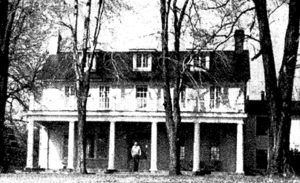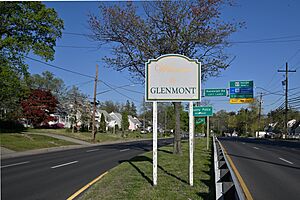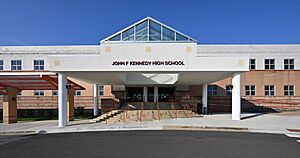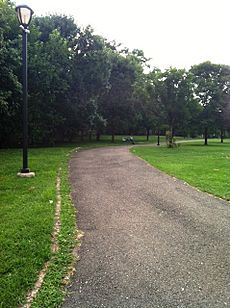Glenmont, Maryland facts for kids
Quick facts for kids
Glenmont, Maryland
|
|
|---|---|
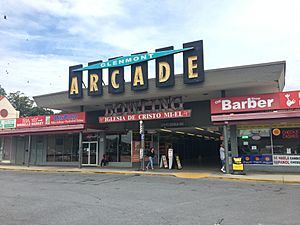
The Glenmont Arcade in October 2018.
|
|

Location of Glenmont in the State of Maryland
|
|
| Country | |
| State | |
| County | |
| Area | |
| • Total | 2.82 sq mi (7.31 km2) |
| • Land | 2.80 sq mi (7.25 km2) |
| • Water | 0.02 sq mi (0.06 km2) |
| Elevation | 390 ft (120 m) |
| Population
(2020)
|
|
| • Total | 16,710 |
| • Density | 5,967.86/sq mi (2,304.09/km2) |
| GNIS feature ID | 2583632 |
Glenmont is a community located in Montgomery County, Maryland, United States. It is known as a census-designated place, which means it's a specific area defined by the government for counting people. In 2020, about 16,710 people lived in Glenmont.
Contents
Glenmont's Location
Glenmont doesn't have official city limits, so its exact borders can be a bit tricky to define. However, the heart of the community is found where Randolph Road and Georgia Avenue (also known as Maryland Route 97) meet.
Glenmont's Past
Old Homes of Glenmont
The Hermitage
A large brick house called The Hermitage was built in 1750 by John Bowie, Jr. His father, John Bowie Sr., came to America from Scotland around 1705. John Bowie, Jr. bought the land for a very low price. He built The Hermitage for his 16-year-old son, Allen Bowie, Jr. The house was located near where Georgian Forest Park is today.
Allen Bowie, Jr. became an important figure. In 1774, he attended a famous meeting in Rockville. There, people strongly criticized Great Britain and decided to stop trading with them. During the American Revolution, Allen Bowie led a group of soldiers and paid for them himself.
Allen's son, Washington Bowie, was born at The Hermitage in 1776. Washington later became a successful merchant and built a mansion in Georgetown, Washington, D.C.. Allen's other son, John, inherited The Hermitage. John was a doctor and fought in the War of 1812.
After John Bowie died in 1825 without children, The Hermitage was held in a trust for other Bowie family members. In 1865, a farmer named J.P. Dodge bought the house and about 160 acres of land. Dodge owned the house for 35 years. His daughters inherited it after he passed away in 1900.
In 1914, Southwick Briggs, a flower grower, bought The Hermitage and 125 acres. He spent a lot of money making the house look nice and planting flowers. After Briggs and his wife died, a company from Washington bought the property. In 1952, The Hermitage was still standing. It was a three-story yellow brick house with a big front porch.
Hermitage II
Hermitage II was another historic house. It was built between 1816 and 1820 by William C. Peerce. The house was made with hand-cut wood and handmade nails. It was located near where Layhill Road and Hathaway Drive meet today. Peerce owned a large amount of land, over 1,000 acres, around the house.
Later, Edward Palmer bought Hermitage II and about 180 acres in 1905. A farmer named Francis P. Welsh bought the house from Palmer in 1920. Then, in 1928, a businessman from Washington named Max Walten bought Hermitage II.
Champayne Farmhouse
The Champayne Farmhouse was built around 1860 by John R. Champayne. It is located at what is now 14201 Layhill Road. John built the house on 114 acres of land he bought. He put the property in his wife Ell's name to protect it from his own family.
When Champayne bought the land, it was covered in pine trees. He cleared the land and built a home, a blacksmith shop, a stable, and other buildings. Ell's family helped by providing wood for the buildings and fences.
By 1880, a second story was added to the house. The land also had apple and peach trees, a dairy, and other shops. That year, the property was sold to Sarah R. Nicholson. The Nicholson family owned the property for many years.
By the 1990s, the Champayne Farmhouse was rented out. The other old buildings on the property were in bad shape. In 2005, new homes were built on much of the land around the farmhouse. The Champayne Farmhouse is still standing today.
How Glenmont Got Its Name
In the 1800s and early 1900s, the area that is now Glenmont had only a few houses and small farms. These were mostly along the Washington–Brookeville Turnpike, which is now Georgia Avenue. The Hardy family had a farm there for many years.
In 1898, Mary Hardy gave the name "Glenmont" to the local post office. This post office was located at what is now Georgia Avenue and Randolph Road. Annie Lofler became the new postmaster in 1900. Even though the post office closed in 1901, the name "Glenmont" stuck, even if it was sometimes spelled "Glenmount."
Glenmont School History
Glenmont's first school opened in 1926. It cost $50,000 to build. In its first year, 136 students attended. Miss Ruth Burroughs was the first principal. The school was located at 12210 Georgia Avenue. This is the same spot where the Glenmont Fire Station moved in 2016.
The brick school building had four classrooms, two special rooms, and an auditorium. It was built after schools in Aspen Hill, Layhill, and Wheaton closed and combined. The Glenmont School served students from Glenmont, Aspen Hill, Layhill, and Wheaton.
In 1928, the American Legion donated an American flag to the school. Major E. Brooke Lee donated a flagpole in memory of Paul Latene Hull, a soldier who died in World War I.
An extension was added to the school in 1946. It included office space and a large area for a gym and cafeteria. More additions were built in 1953 and 1956. However, parts of the original building were later torn down. In 2002, the Maryland Historical Trust decided the school building was not important enough to be listed on the National Register of Historic Places. They felt it wasn't a unique example of suburban growth for the time.
Growing Glenmont: 1940s-1960s
Glenmont was mostly undeveloped until after World War II. Then, new neighborhoods began to be built. In 1948, plans started to make Georgia Avenue wider. In 1949, new stores and homes began to change the rural area of Glenmont. Two big developments were Glenmont Village and Glenmont Forest.
In 1947, the Washington Suburban Sanitary Commission built the Glenmont Water Tower. It was 189 feet tall and could hold 500,000 gallons of water. This water supply helped Glenmont grow with more homes.
The Georgia Avenue Baptist Church was built in 1956. An education building was added in 1962.
The Americana Glenmont, an apartment complex, was built by Carl M. Freeman in 1961 and 1965. It had a modern design and a park-like setting. It was later renamed Glenmont Forest.
Glenmont Shopping Center
The Glenmont Shopping Center is located at the corner of Randolph Road and Georgia Avenue.
In 1952, a group of people announced plans to build a shopping center and 1,000 homes. Construction of the shopping center began in 1956. It was built in stages as new businesses joined. The original stores had large glass display windows. One part of the shopping area, called the "Arcade," had a 24-lane bowling alley. This alley was named after Alphone "Tuffy" Leeman, a famous baseball player.
By 1957, the shopping center had the bowling alley, a dry cleaner, a hardware store, and a restaurant. A Grand Union supermarket opened in 1959. By 1962, the center included a hairstylist, barber shop, shoe repair, insurance agency, restaurants, a hardware store, a savings and loan, a High's Dairy Store, a glass store, a bicycle store, a People's Drug Store, and a post office.
In the early 1990s, the Glenmont Shopping Center started to look a bit run down. People living in Glenmont asked the county and store owners to make improvements. One challenge is that the shopping center is divided into 15 different pieces of land, owned by 12 different people. Because rents are stable and costs are low, the owners haven't had much reason to make big, coordinated improvements.
Getting Around Glenmont
Glenmont is a place where three main roads meet: Georgia Avenue (Maryland Route 97), Layhill Road (Maryland Route 182), and Randolph Road.
The Glenmont Metro station serves the area. This underground train station opened in 1998. It is the last stop on the Red Line and has two large parking garages. From Glenmont, the Red Line goes south through downtown Silver Spring and into Washington, D.C.. It then re-enters Montgomery County, passing through Bethesda and Rockville, and ends at Shady Grove.
Homes in Glenmont
Glenmont has several apartment buildings for rent. These include Privacy World, Winexburg Manor, Glenmont Forest, Woodberry Park, The Glen, Westerly Park, and The Oakfield. Most of the other homes are single-family houses and some townhouses.
Homes west of Georgia Avenue are generally older and smaller. East of Georgia Avenue, the homes are newer and larger. However, some homeowners west of Georgia Avenue have replaced older, smaller homes with bigger, newer ones. About 62% of the homes in Glenmont are owned by the people who live in them. This is a bit less than the 75% homeownership rate for all of Montgomery County.
Glenmont Village is a neighborhood of single-family homes on the west side of Glenmont. These homes were built in 1949 and 1950. Glenmont Village originally had about 350 homes. Two-bedroom houses first sold for $8,890 each. These "modern bungalows" were in the Cape Cod style. They had full basements, gas heat, hot water, and attics that could be expanded. Over the years, many of these houses have been changed and updated.
Glenmont's People
| Historical population | |||
|---|---|---|---|
| Census | Pop. | %± | |
| 2010 | 13,529 | — | |
| 2020 | 16,710 | 23.5% | |
| source: 2010–2020 |
|||
In 2020, Glenmont had a population of 16,710 people. The community is very diverse. Many different backgrounds are represented, including White, African American, American Indian, Asian American, and Pacific Islander residents. A large number of residents also identify as Hispanic or Latino.
Many adults in Glenmont are well-educated. About 43.3% of the population has a bachelor's degree or higher. About 85% have a high school diploma or higher.
The average family income in Glenmont was around $118,095. About 7.4% of Glenmont's residents have incomes below the poverty level.
Most employed residents drive alone to work (51.6%). Others carpool, use public transportation, or work from home. Many people in Glenmont work in management, business, science, or arts.
About 51% of Glenmont's population was born in the U.S. The other 48% were born outside the U.S. Many of these residents have become U.S. citizens. Common family backgrounds reported include Subsaharan African, Irish, German, English, Polish, and Italian.
Schools in Glenmont
Public schools in Glenmont are managed by Montgomery County Public Schools. High school students in Glenmont can attend John F. Kennedy High School, Wheaton High School, or another school in the Downcounty Consortium.
Middle school students attend Argyle, Col. E. Brooke Lee, and A. Mario Loiederman. Elementary school students go to Georgian Forest, Weller Road, Glenallan, or Arcola. Barrie School is a private school in the area for students from kindergarten through twelfth grade.
Glenmont Elementary School was first built in 1935 at the intersection of Randolph Road and Georgia Avenue. It was a two-story building. An addition with a gym and office space was built in 1946. Another addition was built in the 1950s. The school grounds had a play area and a large grassy field. The original school building was torn down in 1980. A different school nearby now uses the name Glenmont Elementary.
Glenmont's Landscape
Glenmont has gentle rolling hills and small streams. These streams are mostly fed by rainwater runoff. However, at least one natural spring still provides water from underground. Streams on the east side of Glenmont flow into the Northwest Branch of the Anacostia River, which then goes into the Potomac River. Streams on the west side generally flow into the Potomac River through Rock Creek. Georgia Avenue roughly divides these two water drainage areas.
Parks and Green Spaces
There are three public parks in or near the center of Glenmont: Glenfield Local Park, Saddlebrook Local Park, and Glenmont Greenway Urban Park.
- Glenfield Local Park is 11.3 acres. It has a sports field, a playground, two tennis courts, a picnic shelter, and a petanque court.
- Saddlebrook Local Park is 14.86 acres. It includes a rectangular field, a playground, and a basketball court.
- Glenmont Greenway Urban Park is about 3 acres. It has an 8-foot-wide asphalt trail and sitting areas. This land is owned by WMATA (the Metro system) but is managed by the Maryland-National Capital Park and Planning Commission (M‐NCPPC) as parkland.
Besides these three, there are 11 other parks close to Glenmont, covering over 1,100 acres. Two of the most important are Brookside Gardens and Wheaton Regional Park. Both are managed by Montgomery Parks, which is part of the M-NCPPC.
In March 2021, the Glenmont Pavilion opened. It is a 1,598 square foot playground located next to the Glenmont Fire Station.
Places to Visit
- Brookside Gardens
- Wheaton Regional Park
- Glenmont Greenway Urban Park
- Glenmont Local Park


